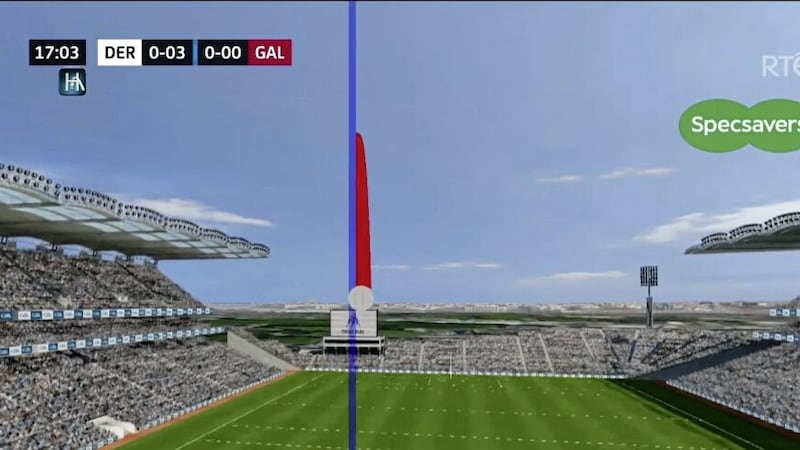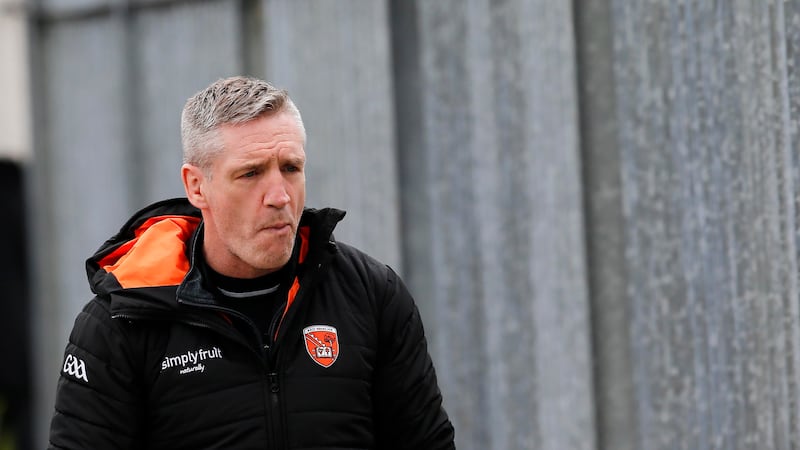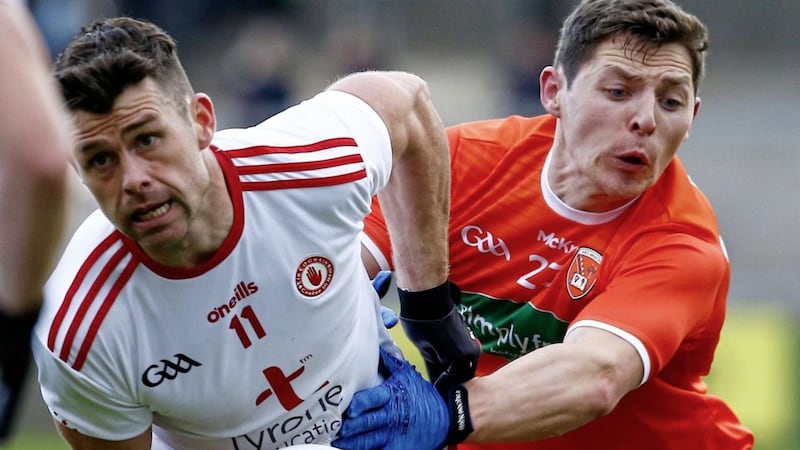HAWKEYE was working correctly for a Conor Glass effort adjudged by the technology to have been wide during Derry’s All-Ireland semi-final defeat by Galway on Saturday, the GAA has insisted.
An issue with the HawkEye system led to it wrongly calling on referee Brendan Cawley to disallow a Shane Walsh point for Galway just before half-time.
The umpires had correctly awarded the score but a call came to the referee through his earpiece, with HawkEye presenting a graphic on the big screen that showed the ball having gone wide.
However, the GAA says that the technology was working properly at the Davin end of the ground, and that an earlier effort from Conor Glass had been given wide in accordance with the way the technology is intended to work.
On that occasion, with Derry leading by 0-3 to 0-0 after 17 minutes, the umpires asked for HawkEye’s assistance in making the decision rather than signaling either a score or a wide.
The Sunday Game highlights show presented an angle from behind the goal that showed the ball inside the post, but the footage was inconclusive in terms of showing the moment at which the ball actually travelled through the posts.
HawkEye’s computer-generated decision showed only a fraction of the ball against the post, with the rest of it inside, which led RTÉ commentator Eamonn Fitzmaurice to query whether the shot would have gone over via the post had the height of the posts been taller.
However, the basis on which the technology was agreed by Central Council is that if any part of the ball touches the woodwork above the height of the post, then HawkEye will deem the shot to have been wide.
“The Conor Glass one, I can confirm HawkEye got that right,” said GAA director of player, games and administration Feargal McGill.
“There was no issue with HawkEye on that one. The umpires called for HawkEye. Video would tend to suggest it was over the bar but HawkEye is telling us it wasn’t, and I’m certain HawkEye is accurate on that.”
Asked how the public could trust the same issues hadn’t happened in front of the Canal End as at the Hill 16 end, McGill added that a review of the system had informed them the problems that had caused the error on Walsh’s effort “were not at play at the other end”.
The HawkEye system will undergo a full range of tests later this week before a decision is made over whether it will be in operation for Sunday’s All-Ireland hurling final, but it is expected that it will be ready.
The technology has had serious question marks placed against it since wrongly calling on referee Brendan Cawley to disallow Shane Walsh’s point.
The umpires had correctly awarded the score but a call came to the referee through his earpiece, with HawkEye presenting a graphic on the big screen that showed the ball having gone wide.
The Irish Examiner reported yesterday that Galway had told the referee at half-time they would not return to the field for the second half unless HawkEye’s decision to rule out Walsh’s score was reversed.
The report said that Galway chairman Paul Bellew and football board secretary Padraig Kelly had gone to the referee’s room at the interval.
McGill told The Irish News that the umpires on the Hill 16 goal where Walsh’s shot was taken were angered by HawkEye’s decision and were adamant that it was a score.
That led to a sequence of events involving GAA officials reviewing the television footage before the officials agreed to reinstate the Galway point, of which both teams and supporters were informed before the start of the second half.
“The referee and the umpires, when they went in at half-time, they were the ones that decided they weren’t happy with this. That kick-started the process,” said McGill.
“They could have, if they’d wanted to, gone out at the start of the second half and told the two managers it was 0-4 apiece, that they felt HawkEye made a mistake.
“Ultimately, it’s down to the match officials and we facilitated them in making the decision.”
Derry manager Rory Gallagher said afterwards that he had no issues with the awarding of the score, saying “it was a score and we’re not going to try and rob them of a score”.
The incidents have nonetheless raised further questions about the long-term suitability of the technology, which was dropped for the second football semi-final between Dublin and Kerry.
It has led some to call into question a number of tight calls in recent games, including the previous weekend’s gripping hurling semi-final between Limerick and Galway.
HawkEye has been at the centre of a number of big moments in hurling since it adjudicated on John O’Dwyer’s last-gasp free for Tipperary in the drawn 2014 All-Ireland final. The technology called the ball wide, sending the game to a replay which Kilkenny won.
Tipp also had a goal disallowed in the 2019 semi-final with Wexford when HawkEye called back to the previous play and awarded a Lee Chin point for Wexford, meaning the game restarted from the puckout and John McGrath’s major off the resulting counter-attack didn’t stand.
Conor McDonald also had a goal chalked off for Wexford in last year’s Leinster final after HawkEye adjudged Liam Ryan’s initial effort to have gone over the bar before it was pulled down into McDonald’s path by Kilkenny ‘keeper Eoin Murphy.
A recent report suggested the GAA is paying “between €7,000 and €8,000” per game for the use of HawkEye, with former president Sean Kelly calling on the association to withhold payment until the issues have been sorted out.








